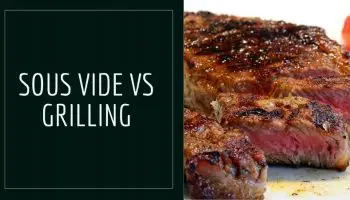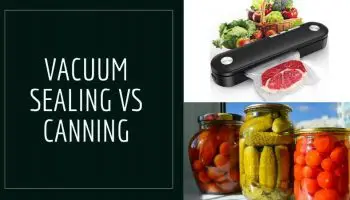Food preservation has been a major concern since time immemorial. For centuries, the human race has been looking for better ways to preserve food.
This has led to many inventions of making food last longer than it normally would. Of course, some methods will work better than others.
But the main thing you should always keep in mind when preserving food is if the method you are using is ideal for your food. Different methods work better for different types of food.
Mylar bags and vacuum sealing are two methods of food preservation that require storing food in bags. However, they both differ and that’s what we are going to be looking at.
Let’s begin with how each method works.
Mylar bags
Mylar bags are metalized polyester bags that resemble aluminum foil. These bags are of a silver opaque material and have varying sizes.
People use them for the storage and preservation of foods that have a moisture content of 10% and below. Simply put, they are best for only dry foods like flour, sugar, rice, whole grains, and dehydrated fruits.
When using mylar bags you will need oxygen absorbers. Oxygen absorbers are small packets filled with iron that absorb 99.99% of oxygen.
They are safe to use with food so you can put them in the food you are storing. You will also need to heat seal your bag.
Heat sealing is a simple process and you will only require an iron for this. You can use a cloth iron or a hair flat iron.
When preserving food in mylar bags, first put the open bag in a bucket. This keeps it stable as you pour in your food.
Pour your dry food into the mylar bag or scoop it in if that works better for you. Ensure that you leave some space at the top to seal your bag sufficiently.
Take out the oxygen absorbers and put them inside your food. One tip for this step is to avoid taking out your absorbers early because they’ll start absorbing oxygen unnecessarily.
You can also seal your bag halfway, place in the oxygen absorbers, then finish up sealing. Do not put oxygen absorbers with sugar because that will leave you with a hard solid block.
Sealing Mylar bags is so much faster than ironing a shirt or flat ironing hair.
All you need to do to seal the bag is to pass your hot iron across the top part of the bag. These irons work just as well as expensive Mylar sealers.
Do not worry if you see the bag still puffed up with air after sealing. The oxygen absorbers will do their magic and after a while, the bag becomes rock hard.
The process of packing your mylar bag is complete and you can now store it in a cool dark place.
| # | Preview | Product | Price | |
|---|---|---|---|---|
| 1 |

|
100PCS Mylar Bags with 400cc Oxygen... | $33.99 | Buy on Amazon |
| 2 |

|
100pcs Mylar Bags for Food Storage with... | $28.99 | Buy on Amazon |
| 3 |

|
10pcs 5 Gallon Mylar Bags for Food... | $29.98 | Buy on Amazon |
Vacuum Sealing
Vacuum sealing involves a vacuum sealer drawing air from a package before sealing it up. You will need a bag for putting in your food and a vacuum sealer.
The bag can be a vacuum sealer bag or a simple Ziploc bag. The sealer can be a simple vacuum sealer machine or the bigger chamber vacuum machine.
All you have to do is to put your food in a bag then place it in the vacuum sealer. The machine will work by drawing out all air from the bag and sealing it which completes the process.
You should store vacuum-sealed packages in the refrigerator to make them last longer.
| # | Preview | Product | Price | |
|---|---|---|---|---|
| 1 |

|
Chef Preserve Vacuum Sealer (Vacuum... | $99.00 | Buy on Amazon |
| 2 |

|
2023 Updated Vacuum Sealer Machine,... | $25.10 | Buy on Amazon |
| 3 |

|
Nesco Deluxe Food VS-12 Vacuum Sealer,... | $114.57 | Buy on Amazon |
What is the difference
Now that we have seen how each method works, let’s look at what differentiates the two from each other.
Food Type
As we have seen, mylar bags store only dry foods. You cannot preserve liquids or anything with above 10% of water content in the bag.
With vacuum sealing, however, you can preserve any type of food. Whether it’s extra flour, leftover stew, or excess soup, you can use vacuum bags without the worry of them going bad.
Shelf Life
Mylar bags store food for longer when compared to vacuum bags. Mylar bags are opaque and they do not allow light in.
Light can deteriorate the quality of food and lower the nutrient content in it with time. Also, when you seal the bags, they cannot let air in which would lead to ruined food.
These reasons make them preserve food for a long time up to 30 years and more.
Vacuum sealer bags are transparent which makes them let in light and their seals loosen over time making air get in. Vacuum sealed food cannot last for too long and the longest period is 3 years.
Refrigeration
Mylar bags do not need refrigeration. You can simply place them in dark cool places and they will keep your food good to eat.
When you refrigerate them, they tend to have holes which will make food go bad fast.
Vacuum sealed bags are great in the freezer. After all, you need to refrigerate them for the food to last longer.
In the fridge, the bags can stay for as long as 3 years in perfect condition. The food will have no freezer burn and no slightest change in taste, texture, moisture, or nutrients.
Quantity
Mylar bags are great for bulk quantities of food. If you have many bags to store that you won’t be using any time soon, it’s the perfect method for you.
Vacuum sealed bags are perfect for small food potions like meal prepping or food that you don’t need to store for long. The bags are usually in small sizes for small food quantities that you can divide for your meal prepping.
Packaging
Mylar bags are good options for large food quantities. This means that you may have several bags to stock up if you choose it.
Putting food in the bags and sealing them may take you a while. Vacuum sealing is usually for smaller foods and the method will take you a shorter while compared to mylar bag storage.
Recap
So now you have seen the differences between these two processes. They are both efficient and each works better for different food types and quantities.
You should pick the one that suits you better according to the type of food you want to preserve, how much it is, and how long you want to store it.



